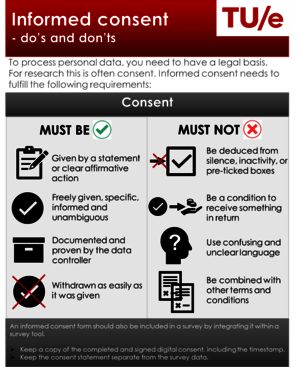If you collect and process personal data from participants you need to have a legal basis to do so. In research, this is often the informed consent. By explicitly asking participants' permission to collect their personal information for specific purposes, it gives them an opportunity to gain understanding, seek clarifications, and make an informed choice about their participation. By providing participants with sufficient information and choice, you fulfil both your legal and ethical requirements. For that, you need to adequately draft an informed consent form.
How to draft an informed consent form
When you get people's personal information, it is really important to tell them how you are going to use it.
You need to at least explain:
- What your research is about and who is on your team.
- The purpose of the processing, which personal data you are going to collect and how you are planning to use it.
- Make sure to highlight if the data will be made available for reuse.
- The rights participants have, like the ability to withdraw consent or possibility to contact the university's Data Protection Officer or Privacy Team in case of questions regarding personal data handling.
- Extra information for special situations, for example, if you are planning to share data with an external party or outside of the EU/EEA, or you apply automatic decision making (e.g., profiling) in your project that affects the data subject.
Typically, written consent documentation includes an information sheet which explains the overall project and purpose for personal data collection, and a shorter consent form which is signed by a participant. It is important to describe the goal of the data collection and envisaged use of the personal data, also in future research. The use of data is limited to the specific processing and purpose described in the form and no use outside those areas is permitted. Do you have multiple purposes for processing data? If so, you must inform the data subject about this and ask permission for each purpose separately. The purpose may not change along the way.
Consent can be given by signature, digital signature, check mark or even verbally recorded (the latter for example in online interviews that are recorded). For children under the age of 16, it is necessary that the parent/guardian gives consent (this may differ per EU country).
Privacy Team has created TU/e templates for informed consent forms. We highly recommend using these templates in your research. Please note that the participants of the research should be able to understand the participant information and informed consent form. This means that while choosing a correct template you need to select one that is compatible with participants' language comprehension (Dutch and/or English). If you need help with completing the informed consent template or have any questions please contact a data steward.
Remember, that informed consents should also be stored for 10 years (non-medical research, either in digital or paper form, after digitization papers forms can be destroyed after six months), 15 years ( WMO research, wet signature paper informed consent forms) or 25 years (for clinical trials, paper forms cannot be destroyed after digitization).
